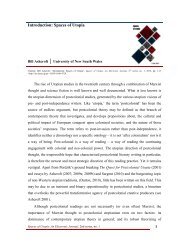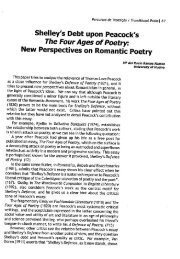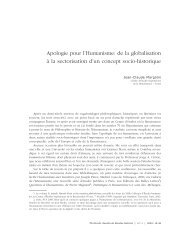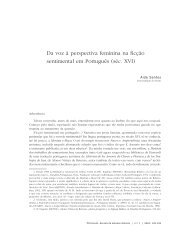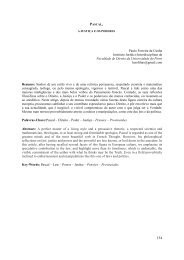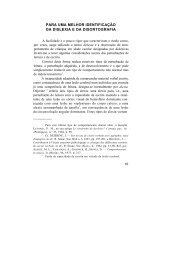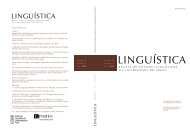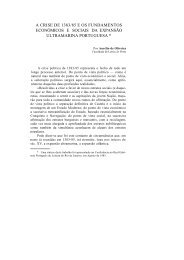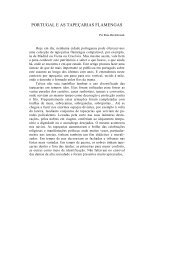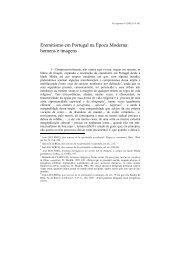Bilbo Baggins: An (Un)expected Hero
Bilbo Baggins: An (Un)expected Hero
Bilbo Baggins: An (Un)expected Hero
You also want an ePaper? Increase the reach of your titles
YUMPU automatically turns print PDFs into web optimized ePapers that Google loves.
that same place. This happens with (for instance) Hobbiton, Long Lake and<br />
Lonely Mountain.<br />
Also important are the aesthetical strategies introduced by J.R.R. Tolkien<br />
in this narrative. Throughout the story we find oral markers and typical elements<br />
of the tale and children’s literature, such as songs (that the Dwarves are<br />
constantly performing), riddles (as in Gollum’s cave), many repetitions (as the<br />
sentence “It was not the last time he wished that”), enumerations (as the<br />
constant references to the Dwarves name, and usually for a certain order<br />
“Thorin, Dori, Nori, Ori, Balin, Dwalin, Fili, Kili, Oin, Gloin, Bifur, Bofur, Bombur”)<br />
or the listing of actions (as happens in the conversation with Smaug, when the<br />
things <strong>Bilbo</strong> made are listed in an attempt to show that <strong>Bilbo</strong> was not as<br />
innofensive as Smaug might think, and, at the same time, remind the reader of<br />
the heroic attitudes the Hobbit had already performed). <strong>An</strong>other examples of<br />
aesthetic strategies are the use of “interrogatio” (a sequence of rethorical<br />
questions), as happens in the first time <strong>Bilbo</strong> sees Gandalf, and the use of<br />
epithets, such as “Thorin Oakenshield”, “son of Thrain, son of Thror” and “King<br />
under the Mountain” all applied to Thorin and that are another feature that<br />
approximates The Hobbit of There and Back Again to the classic epic, once that<br />
it was extremely usual in works such as Homer’s Iliad (think on the phrases<br />
“Son of Peleus”, “Swif-footed” or “God-like” applied to Achilles).<br />
<strong>An</strong>other central issue to take into account is the narrator itself. This<br />
narrator is an omniscient one, which means, that despite the fact that he is not a<br />
direct participant in the story, he knows both everything what happened, and<br />
what’s to come. In fact, he uses his knowledge of the future of the story to give<br />
hints on its development (remember the so many times repeated sentence “It<br />
was not the last time he whished that”). This hints the narrator gives are an<br />
element of comparison with Gandalf – the wizard shows himself as being the<br />
character with more knowledge of the future (“You will thank me before all is<br />
over”), and knowing so, he presents himself as being the wiser element of the<br />
group – as the same happens with the narrator, his words win credibility and the<br />
reader becomes eager to rely on what he relates. By knowing the whole story,<br />
the narrator has the freedom to control the times of the narration. He seems to<br />
give the more importance to the quest itself and to the defeating of Smaug<br />
(chapter 14), moment when the narration pace increases and the action speeds<br />
up, as if the main boundary was left behind. The returning home is only<br />
mentioned in telegraphic terms, despite the (more than probable) problems the<br />
group had to overcome, especially if we consider that they took a very similar<br />
way to the (so hard) route they took when they made the trip the other way<br />
round.<br />
By all these reasons, the approximation between The Hobbit of There<br />
and Back Again and the classic epic is inevitable, and subsequently the<br />
comparison betwenn <strong>Bilbo</strong> <strong>Baggins</strong> and the classic hero becomes unavoidable.<br />
This way, the main, and only character with his story closed at the end of the<br />
book, can be seen as a kind of “self-made-hero”, once that despite not beeing<br />
intrinsically heroic, <strong>Bilbo</strong> <strong>Baggins</strong> overcomes all the troubles that he has to fight,<br />
and works his way as a hero throughout the story. <strong>Bilbo</strong> <strong>Baggins</strong> is then the<br />
most heroic character and the only possible hero in an epic where are no…<br />
heroes...<br />
47



